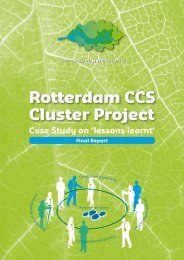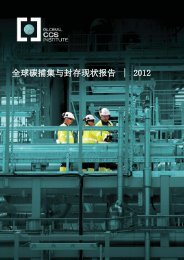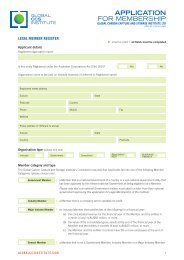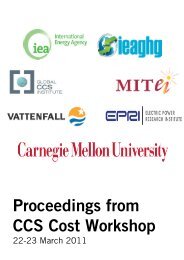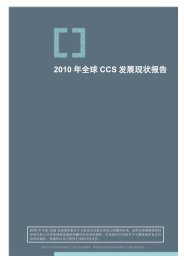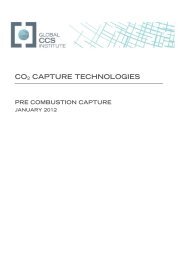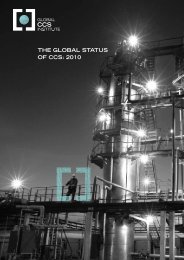eceived information about natural phenomena involving CO 2 (e.g., the Lake Nyos incident)perceived CO 2 as more dangerous, but did not report that they had a more negative impression <strong>of</strong>it. Essentially, respondents who had no specific opinions on <strong>CCS</strong> initially moved towards a morepositive or negative opinion depending on the information provided. This highlights the importance<strong>of</strong> receiving reliable and balanced information in order to be able to form an opinion. It also meansthat people do not automatically become more positive about the technology if they know moreabout it or understand it better, but their opinions become more informed and more stable.Effects on <strong>CCS</strong> perceptionsMost respondents maintained the same opinion <strong>of</strong> <strong>CCS</strong> after the provision <strong>of</strong> information about it.Those who did change their opinions tended to perceive <strong>CCS</strong> as less positive, less clean, and lesssafe. Despite the fact that misperceptions <strong>of</strong> <strong>CCS</strong> relate to misperceptions <strong>of</strong> CO 2 , little changeoccurred in <strong>CCS</strong> perceptions when respondents were provided with information about CO₂’scharacteristics, natural phenomena relating to CO₂, CO₂ behaviour during <strong>CCS</strong>, or several <strong>of</strong> thesepieces <strong>of</strong> information. Three slight changes did occur:• Information on CO₂ characteristics (i.e., properties and chemistry) increased the perception <strong>of</strong><strong>CCS</strong> as a mature technology.• <strong>Perceptions</strong> <strong>of</strong> safety were damaged by information on CO 2 natural phenomena, particularly MtMammoth.• Information about the behaviour <strong>of</strong> CO 2 in <strong>CCS</strong> (particularly about induced seismicity)negatively influenced impressions <strong>of</strong> <strong>CCS</strong> as positive, clean (particularly related to the smallchance <strong>of</strong> CO 2 leakage), and safe (particularly related to topsoil acidification risk).In instances where changes in perceptions did occur, the type <strong>of</strong> knowledge presented led todifferent effects. For example, perceptions <strong>of</strong> <strong>CCS</strong> as ‘positive’, ‘clean’, ‘useful’ and ‘dangerous’were affected negatively and significantly by the provision <strong>of</strong> all sets <strong>of</strong> information. As anotherexample, informing participants <strong>of</strong> CO 2 ’s behaviour during <strong>CCS</strong> had mixed effects on perceptions(e.g., transport was viewed more positively, but earthquake risks were viewed more negatively);these effects may have cancelled each other out. This pattern demonstrates the importance <strong>of</strong>conveying complete and correct information on CO 2 ’s characteristics, as greater understandingcould mitigate issues that may arise when respondents receive incomplete information about <strong>CCS</strong>,such as by means <strong>of</strong> a single negative anecdote.Effects on attitudes towards implementationThe majority <strong>of</strong> respondents did not change their opinions on <strong>CCS</strong> implementation between thefirst and second assessment. The influence <strong>of</strong> respondents’ demographics was also somewhatconsistent between the two assessments. Respondents who had not changed their opinions werefound to have greater pre-existing knowledge <strong>of</strong> CO 2 ’s properties and characteristics; as such, theymay have tended to form their opinions based on their own knowledge and experience rather thanthe information that was provided to them as part <strong>of</strong> the survey. Respondents’ perceptionsregarding the risks and necessity <strong>of</strong> <strong>CCS</strong> were found to have the greatest influence on overallopinions on <strong>CCS</strong> implementation: the perception that <strong>CCS</strong> entailed too many risks to human healthhad a negative effect, while the belief that <strong>CCS</strong> is essential to mitigate climate change positivelyinfluenced opinions on <strong>CCS</strong> implementation.In general, the effects <strong>of</strong> information provision on respondent opinions <strong>of</strong> <strong>CCS</strong> implementationwere weak but consistent. It was noted that there was high collinearity among the covariatesbetween the pieces <strong>of</strong> information in package B (i.e., regarding Lake Nyos, Japanese hot springs,the paint factory incident, Mt. Mammoth, and natural CO 2 storage domes) and package C (i.e.,46 | Understanding how individuals perceive carbon dioxide
egarding the behaviour <strong>of</strong> CO 2 in <strong>CCS</strong>). The Mt Mammoth effects stood out particularly; however,the paint factory accident information and the Lake Nyos information led to more or less the sameeffects. Information on induced seismicity due to <strong>CCS</strong> was also seen as important. The informationon CO 2 ’s behaviour in capture and transport provided a positive effect on <strong>CCS</strong> implementationperceptions, and information on the possibility <strong>of</strong> CO 2 leakage via cracks had a negative influence.Generally, as knowledge about CO 2 increased, the tendency towards definitive/ pronounced (i.e.non-neutral) opinions about <strong>CCS</strong> implementation also increased, although in terms <strong>of</strong> opinionsabout <strong>CCS</strong> ‘<strong>of</strong>fshore’, the tendency was weak. This may imply that it is harder to form opinionsabout <strong>CCS</strong> ‘<strong>of</strong>fshore’ compared with <strong>CCS</strong> ‘in your country’ or ‘in your neighbourhood’ through theinformation about <strong>CCS</strong> that was provided in this research. It may be that respondents asked toprovide an opinion about <strong>of</strong>fshore implementation feel they are being asked to speak aboutsomething that is not meaningful to them at the moment. However, it is understandable that it mayhave been difficult for respondents to change opinions substantially by learning through informationprovision in such a short space <strong>of</strong> time as occurred in the survey, regardless <strong>of</strong> the content <strong>of</strong> theinformation provided.8.4 SummaryIn summary, respondents were found to have reasonable general knowledge <strong>of</strong> CO 2 but poorknowledge <strong>of</strong> some <strong>of</strong> its scientific dimensions such as flammability and health effects, giving themthe opportunity to misunderstand and perceive it incorrectly. Their misperceptions <strong>of</strong> CO 2 weredirectly related to their misperceptions <strong>of</strong> <strong>CCS</strong>, yet only indirectly related to their opinion on <strong>CCS</strong>implementation. Influences <strong>of</strong> information provision were statistically significant but weak. Due tothe survey’s large sample size, these influences could be distinguished; they break down amongthe general information categories as follows: information on CO 2 natural phenomena and CO 2behaviour in <strong>CCS</strong> had a negative effect, while information on CO 2 characteristics (specificallyproperties and chemistry) had a favourable effect on <strong>CCS</strong> perceptions and <strong>of</strong>ten mitigated thenegative effects <strong>of</strong> the other information. The next chapter comments on how to act on thesefindings.Understanding how individuals perceive carbon dioxide | 47




